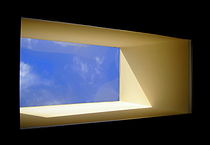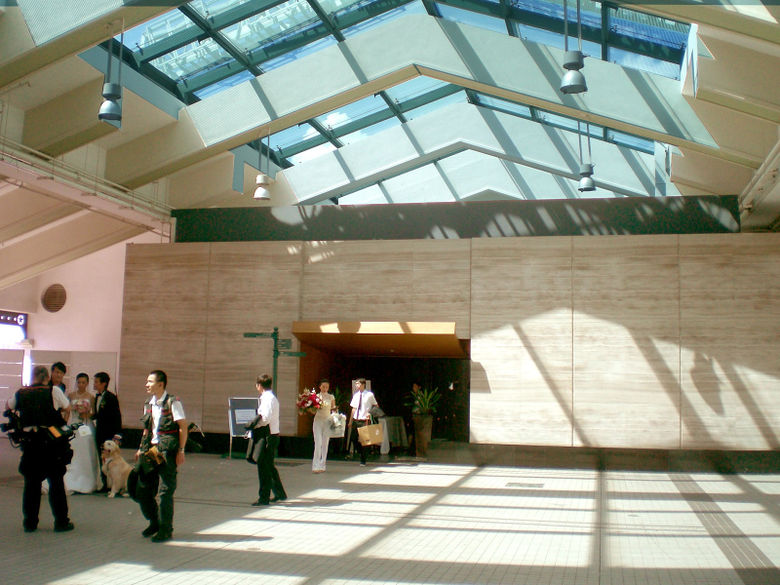Daylighting

Daylighting is the process of using natural sunlight to light a building to help reduce energy costs, especially in commercial buildings.[2] The process of daylighting includes controlling how much natural light (both diffuse and direct) enters a building.[3] Essentially, daylighting is a way to provide energy services without using fuels, just the direct use of primary energy flows.
Although the general goal of daylighting is to reduce the amount of necessary electric lighting and save energy, it is important not to let too much light into the building. Because of all of the thought that must be put into daylighting, it requires a lot of planning. Daylighting includes features such as skylights and windows that let light in, but these are generally accompanied by a lighting control system that is responsive to the amount of daylight entering the building. When enough daylight enters the building, these systems dim or turn off lights.[3]
Methods
There are numerous ways that sunlight can be used advantageously inside buildings. Some traditional techniques to improve natural lighting in buildings are listed below.
Windows and Skylights
The strategic installation of skylights, such as the ones shown in Figure 2, allows natural light to enter a building through the ceiling. These can be especially useful in providing light when the Sun is high in the sky. In addition, the installation of tall windows allows outside light to easily enter rooms. As mentioned above, the placement of these windows must be carefully considered to minimize potential glare. Solar shading devices known as overhangs can be used to minimize the direct Sun that enters the space.[3]

Building Design
There are numerous design changes that can be made on buildings to increase the amount of natural light that can enter the building. One way to improve the amount of natural light in a building is to build with a shallow-plan design. This simply means buildings are designed so that daylight can enter all rooms and hallways, the building is "shallow" enough that light can penetrate all the way in.[2] The installation of task lighting (lighting directly over work spaces) can also help reduce energy costs as it reduces the need to light the entire room.[2]
Light Tubes and Fibre Optics
There are also a number of more experimental techniques being used in an attempt to direct light into buildings. One of these methods is by using steerable mirrors to direct light into areas it would not normally reach. As well, the use of optical fibers and light ducts to spread natural light through a building is currently being experimented with.[2] Light ducts are simply tubular devices that are coated with a reflective film that channel light from the roof of a building to the interior ceiling. They are beneficial as they are much smaller than skylights, but just as effective.[3] Fibre optic lighting devices send light through a bundle of optical cables into a building using a physical mechanism known as total internal reflection. This simply means that the light in the cables bounces around on the inside of the cable, being transported as it reflects.
Benefits
The benefits of daylighting can be extensive, mainly because electric lighting accounts for anywhere between 35% to 50% of electrical energy consumption in commercial buildings.[3] In the summertime the heat created by electric lights can cause the building to overheat. Thus, using daylighting techniques can reduce the energy used to cool these buildings by 10-20%.[3] For some commercial buildings, total energy costs can be reduced by as much as 1/3 through strategic use of daylighting technologies.[3]
In addition to saving money, reducing the amount of electrical energy used also reduces the amount of greenhouse gases released that are associated with the production of said energy.
Finally, studies have shown that being exposed to sunlight can improve mood. In a workplace, the presence of natural light in the building can boost mood and productivity as the brain produces more of a mood-lifting chemical known as serotonin on sunny days. Including natural lighting can reduce symptoms of seasonal affective disorder, which include difficulty concentrating, low energy, loss of interest, and moodiness.[5]
For Further Reading
- Sunlight
- Fenestration
- Skylight
- Window
- E-coating
- Fuel vs flow
- Or explore a random page
References
- ↑ Wikimedia Commons. (August 10, 2015). Daylighting - Skylight [Online]. Available: http://commons.wikimedia.org/wiki/File:Daylighting_-_Skylight.jpg#/media/File:Daylighting_-_Skylight.jpg
- ↑ 2.0 2.1 2.2 2.3 G. Boyle. Renewable Energy: Power for a Sustainable Future, 2nd ed. Oxford, UK: Oxford University Press, 2004.
- ↑ 3.0 3.1 3.2 3.3 3.4 3.5 3.6 Whole Building Design Guide. (August 10, 2015). Daylighting [Online]. Available: https://www.wbdg.org/resources/daylighting.php
- ↑ Wikimedia Commons. (August 10, 2015). Central Star Ferry Pier [Online]. Available: https://upload.wikimedia.org/wikipedia/commons/b/b7/HK_Central_Star_Ferry_Pier_7_Shop_L_Restaurant_WaterMark_a2.jpg
- ↑ WebMD Health News. (August 12, 2015). Unraveling the Sun's Role in Depression [Online]. Available: http://www.webmd.com/mental-health/news/20021205/unraveling-suns-role-in-depression

